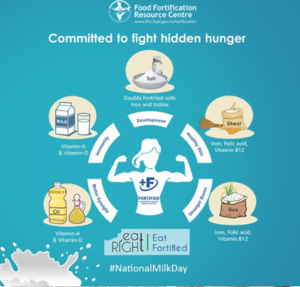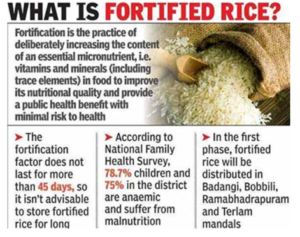Fortified rice fights hidden hunger
Relevance
- GS 3: Public Distribution System – Objectives, Functioning, Limitations, Revamping; Issues of Buffer Stocks and Food Security
- Tags : #FoodFortification #HiddenHunger #IndiaNutrition #FoodSecurity #MintEditorial #UPSC #PoshanMaah #PoshanAbhiyaan #Malnutrition #HungerIndex #CurrentAffairs
Why in News?
India faces significant challenges related to micronutrient deficiencies and hidden hunger. While progress has been made, especially in food fortification efforts, addressing these issues remains crucial for the nation’s health and development.
Hidden Hunger in India
- Hidden hunger is a condition caused by micronutrient deficiencies, leading to malnutrition due to insufficient intake or absorption of vitamins and minerals.
- Hidden hunger remains hidden until clinical signs of deficiency become apparent.
- It affects the overall health and development in children and disrupts normal physical and mental functions in adults.
- Hidden hunger can result in birth defects, impaired cognitive abilities, maternal and infant mortality, childhood blindness, and reduced productivity.
- While balanced and diverse diets should provide necessary micronutrients, humans often can’t produce these internally, except for vitamin D.
Persistent Hunger in India
- Slow Progress: Hunger rates in India have improved gradually.
- A 2020 report by the Tata-Cornell Institute revealed that around 194 million people in India were undernourished during 2016-18.
- This number reflects only an 8% decrease from the 210 million undernourished individuals in 1990-92
Malnutrition Crisis in Aspirational Districts
Inadequate Child Nutrition
- In Aspirational Districts, as per the Social Progress Index 2022, only 12.32% of children aged 6-23 months receive proper nutrition.
- Over 690 districts have less than 30% of children receiving adequate nutrition, and 17 districts see over 50% of their children facing stunting.
Anaemia Prevalence
- Anaemia prevalence among women and children stands at an average of 61.20%.
- In 67 Aspirational Districts, less than 12% of children receive a sufficient diet.
Inadequate Dietary Habits
- India’s daily calorie consumption falls below the recommended 2,503 kcal per capita per day.
- Only 6-8% of calories come from protein sources.
- A preference for processed foods over fruits and excessive cereal consumption worsens the issue.
Food Fortification in India
- India’s journey to combat hidden hunger started in the 1950s with initiatives like vegetable oil fortification and salt iodization.
- In the 2000s, staples like rice and wheat were also fortified.
Historical Significance of Food Fortification
- Food fortification has a rich history dating back to 1920 when iodine was added to table salt in Ohio to prevent goitre.
- Understanding the role of micronutrients in diseases goes as far back as 1753 when James Lind’s trials on sailors discovered lime juice’s efficacy against scurvy.
- These historical milestones highlight the crucial role of fortification strategies in addressing hidden hunger and enhancing nutrition.
Fortified Rice: Enhancing India’s Nutritional Security
The Indian government is on a mission to fortify rice in all social safety net programs by 2024, with the expenses covered by the state.
- The program has seen remarkable progress, increasing Fortified Rice Kernel (FRK) manufacturing capacity to bolster the nation’s nutritional security.
The initiative is unfolding in phases.
- Phase-I includes Integrated Child Development Services (ICDS) and the Prime Minister’s Poshan Abhiyan.
- Phase-II extends to the targeted Public Distribution System (PDS) across 27 states and Union territories.
- Full Coverage by 2024: Phase-III, scheduled for completion by March 2024, aims for comprehensive implementation across all remaining districts, except predominantly wheat-consuming regions.
- Health Promotion: The widespread distribution of fortified rice will enhance its availability and accessibility, contributing to the nations overall health and well-being.
Fortification Standards and Initiatives
- The fight against malnutrition received a boost in 2016 when the Food Safety and Standards Authority of India (FSSAI) set fortification standards for rice, wheat flour, edible oil, double fortified salt (DFS), and milk.
- A Food Fortification Resource Centre was established.
- The ‘F+’ logo was introduced, encouraging food producers to participate.
- Mandated Usage: Fortified staples like DFS and fortified edible oil were made mandatory in safety net programs, furthering the mission’s impact.
Cost-Effective Rice Fortification
The cost-effectiveness of rice fortification varies based on factors like the rice industry’s structure, supply chain complexity, policies, and program scale.
- Low Initial Costs: A basic machine costs ₹35-40 lakh, while a high-quality one is pricier at ₹13.5 crore.
- Additional Costs: Fortified rice carries additional costs of 1% to 10% of the retail price, approximately ₹0.45 per kg for consumers, depending on the added nutrients.
- Economies of Scale: As production and distribution expand, costs are expected to decrease through economies of scale.
Addressing Micronutrient Malnutrition in India
Micronutrient malnutrition remains a significant challenge in India, hindering human capital development, labor productivity, and social and economic progress, despite its youthful demographic profile.
Role of Food Fortification
- Food fortification has become a pivotal measure to combat malnutrition and improve public health.
- India’s national initiatives, such as PM Poshan and Anaemia-Mukt Bharat Mission, emphasize the importance of food fortification and supplementation.
- The Food Safety and Standards Authority of India (FSSAI) actively promotes fortification of staple foods, including oil, milk, wheat flour, rice, and double fortified salt (DFS).
- Focus on Rice Fortification: Among various fortification interventions, rice fortification is considered an effective strategy to address nutrient deficiencies.
Achieving equitable access to fortified foods in India demands sustained government investment, along with overcoming challenges such as raising awareness, managing costs, ensuring widespread availability, and fostering better stakeholder coordination. Dedicated efforts can lead to substantial progress in improving the nation’s nutritional status through this strategic approach.
Source: Mint
Mains Question
Discuss the importance of food fortification in addressing micronutrient deficiencies in India. Highlight the government’s initiatives in this regard and their impact on improving public health and nutrition?





